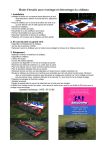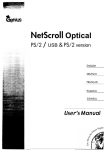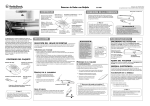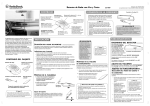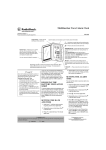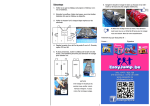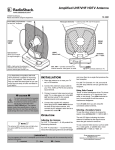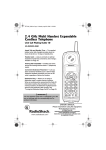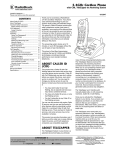Download 27MHz Wireless Keyboard and Mouse
Transcript
27MHz Wireless Keyboard and Mouse OWNER’S MANUAL — Please read before using this equipment. 26-750 Thank you for purchasing the Compaq 27 MHz Wireless Keyboard and Mouse. The wireless keyboard lets you move it freely from your computer within 2 meters range and the keyboard’s 19 hot keys are convenient for one touch access to your favorite Internet, e-mail, and programs such as Word, Excel, and Power Point. The wireless mouse’s buttons can be programmed to control movements frequently used in Windows, for example, double clicks, zoom in and out, shift key, scroll, copy, paste, enter, page up and down, and so on. Your wireless mouse and keyboard system is fully compatible with IBM/AT and PS/2, Windows 95 (PS/2 only) Windows, 98, 2000, ME, XP. Wireless Keyboard Wireless Mouse ! IMPORTANT ! If an icon appears at the end of a paragraph, go to the box on that page with the corresponding icon for pertinent information. ! — Important Ô — Note Receiver © 2003 RadioShack Corporation. All Rights Reserved. RadioShack and RadioShack.com are trademarks used by RadioShack Corporation. Compaq is registered by the U.S. Patent and Trademark Office. CONTENTS System Requirements .................................................................................................................................. 3 A Quick Look ................................................................................................................................................ 4 Mouse ....................................................................................................................................................... 4 Keyboard Hotkeys ..................................................................................................................................... 4 Media Keys ........................................................................................................................................... 4 Internet Keys: ........................................................................................................................................ 5 Others ................................................................................................................................................... 5 LED Indicators on the Receiver ............................................................................................................ 6 Hardware Installation ................................................................................................................................... 7 Connecting the Receiver to Your Computer .............................................................................................. 7 Installing Batteries ..................................................................................................................................... 7 In the Keyboard .................................................................................................................................... 8 In the Mouse ......................................................................................................................................... 8 Setting Up The Keyboard .......................................................................................................................... 9 Using the Keyboard’s Palm Rest and Elevation Tabs .......................................................................... 9 Wireless Keyboard, Mouse, and Receiver ............................................................................................ 9 Setting the ID Channel .......................................................................................................................... 9 Software Installation ................................................................................................................................... 10 Wireless Mouse And Keyboard Setting Menu ......................................................................................... 10 Customizing the Mouse Settings ........................................................................................................ 11 Mouse Button Assignments ................................................................................................................ 11 Application Switch/Document Switch .................................................................................................. 13 EasyJump for Windows ..................................................................................................................... 14 Zoom function for Office and IE Applications ...................................................................................... 15 Setting Wireless Mouse Options for Internet .......................................................................................... 15 Setting The Keyboard’s Hotkeys ............................................................................................................. 15 Setting the Media Key ......................................................................................................................... 16 Setting the Play/Pause Key ................................................................................................................ 16 Setting the Search Key ....................................................................................................................... 17 Setting the Web/Home WWW Key ..................................................................................................... 17 Setting the Mail Key ............................................................................................................................ 18 Setting the “My Computer” Key ........................................................................................................... 18 Setting the Calculator Key .................................................................................................................. 19 Setting the Sleep Key ......................................................................................................................... 19 Setting Options for Displaying the HotKey Icon .................................................................................................................................. 20 Setting the Wireless Function ............................................................................................................. 20 Troubleshooting .......................................................................................................................................... 21 FCC Declaration of Conformity .................................................................................................................. 22 The FCC Wants You to Know ..................................................................................................................... 22 Care ............................................................................................................................................................ 23 Cleaning the Wireless Mouse ................................................................................................................ 23 Service and Repair ..................................................................................................................................... 23 Environment Requirements ........................................................................................................................ 24 2 SYSTEM REQUIREMENTS TM • IBM -Compatible PC, with 80486 processor or above • 8 MB RAM minimum (16 MB recommended) • 10 MB hard-disk space • CD-ROM drive • PS/2 keyboard port. (If your system has an AT computer (IBM compatible) keyboard port, you will need one more AT socket to PS/2 socket adapter, available at your local RadioShack store.) • PS/2 mouse port. • Windows 95 (PS/2 only) Microsoft Windows 98/Me, or Windows NT 4.0 (with Service Pack 3 or later version), or Windows 2000/XP installed. • Microsoft Windows Media Player 6.4 and CD Player installed or Windows Media Player 7.0 installed. Your wireless keyboard and mouse system’s features include: 256 Channel ID Number Selections — lets you select a different channel ID number to prevent any possible radio frequency interruption. One-Touch Popular Multimedia Function Keys — allow one touch operation of Mute, Volume up, Volume down, Previous-track, Next-track, Stop, Play and Pause functions. One-Touch Applications Keys — allow one touch access to Internet functions such as My Favorite, Search, E-mail, WWW, Windows My Computer desktop, Windows’ calculator. Four LED Mode Indicators — indicate mouse operating status, battery power status, Number Lock, Caps Lock, and Scroll Lock function status. Foldable Keyboard Palm Rest — lets you rest your palms comfortably for extended use of the keyboard. Ergonomic Mouse Design — lets you hold the mouse comfortably. Optical Sensing Technology — senses mouse movement precisely and smoothly, with no moving parts to replace. USB to PS/2 Adapter — lets you use your mouse with computer either with PS/2 or USB connector. 3 Mouse Scroll Wheel — lets you scroll and select quickly and easily, helping you work with long documents. Supplied Driver CD — provides various customized functions for operation with the Internet and Windows. A QUICK LOOK MOUSE Left Mouse Button Side Button Side Button Scroll Button Right Mouse Button Left Button: The left button is a default click button. You do not need to set this button. Right Button — You can assign this for frequently used keyboard buttons and mouse functions in addition to features like Easy-Jump, Auto-Panning, Zoom, and so on. Scroll Button — You can assign this button for frequently used keyboard buttons and mouse functions in addition to features like Easy-Jump, Auto-Panning, Zoom, and so on. Side Button — You can assign certain functions in the Mouse Properties menu to the left or right side button with the roller button. 4 KEYBOARD HOTKEYS Media Keys — starts the media player that you select. F — moves audio or video CD to previous track. J — moves an audio or video CD to the next track. 9 — Play and pause an audio or video CD. D — stops playing an audio or video CD. Volume + or – ] — increases or decreases volume. Mute — mutes the sound of an audio or video CD being played. Internet Keys My Favorites — displays your Favorites or Bookmarks list for the Internet. Search — goes to your Internet search service. E-mail — access an E-mail application such as Outlook Express. WWW Back — access the internet browser application. — returns to the previous web page. Forward Stop — moves to the next web page. — stops loading or refreshing a new web page. Refresh — updates the content on a web page. Others My Computer Calculator Sleep — displays <My Computer>. — access the Windows’ Calculator. — turn system into sleep mode. LED Indicators on the Receiver There are four LED indicators in the receiver. 1. The top LED lights either red or green as follows: • lights red when the mouse battery power weakens and turns off when fresh batteries are installed. 5 • lights red when the keyboard battery power is low. The LED only flashes when a key is pressed on the keyboard while the batteries are low. • flashes green slowly when the receiver is preparing to operate. • flashes green rapidly when the mouse moves and goes off when the mouse stops. • flashes green slowly when you hit a key on the keyboard and goes off when you stop. 2. The second green LED lights when Scroll Lock is set to on and turns off when Scroll Lock is released. 3. The third green LED lights when Caps Lock is set to on and turns off when Caps Lock is released. 4. The last green LED lights when Num Lock is set to on and turns off when Num Lock is released. 6 HARDWARE INSTALLATION CONNECTING THE RECEIVER TO YOUR COMPUTER The connectors of the RF (Radio Frequency) receiver meet the PC 99 Spec. If you have a computer with PC 99 specification, simply plug the purple connector marked with to the same color PS/2 port, or connect the supplied USB to PS/2 adapter to the USB connector and connect it to the mouse’s USB port. Refer to your computer’s manual for the location of PS/2 ports. ! Ô If your computer is AT type (IBM compatible), please contact your local RadioShack for the optional adapter. PS/2 ! IMPORTANT ! Keep your previous mouse installed as a back-up until you finish installation Ô NOTE Ô Before installing or removing the keyboard or mouse (either the original or the new one) to or from your computer, always turn off your computer first. Installing or removing the keyboard or mouse while the computer is running can cause permanent damage to them or your computer. USB INSTALLING BATTERIES The wireless keyboard and mouse require two AA batteries each (not supplied) for power. We recommend RadioShack alkaline batteries. 7 In the Keyboard Tabs Battery Compartment Cover 1. Push up on the tabs to lift and remove the battery compartment cover on the bottom of the keyboard. 2. Insert two AA batteries into the battery compartment according to the polarity marked inside the battery compartment. 3. Replace the battery compartment cover. In the Mouse 1. Press the latch on the top of the battery compartment cover. Then lift off the cover. 2. Insert two AA batteries into the battery compartment according to the battery polarity marked inside the compartment. 3. Replace the cover. 8 SETTING UP THE KEYBOARD Using the Keyboard’s Palm Rest and Elevation Tabs If your desktop space is large enough, you may use the palm rest which supports your forearms for comfortable operation. Simply turn the keyboard over, then lift the palm rest towards you. Turn the keyboard back over. To return the palm rest to it’s original position, flip it backwards until it clicks into place. ! IMPORTANT ! • Do not use the keyboard or mouse on a desk made of glass, mirror, iron, or black velvet. A flat surface is necessary for the optical sensor to work. • For normal transmit distance, avoid using this device on a metal surface because a large surface of iron, aluminum, copper, or other metal will shield or ground the keyboard’s or mouse’s RF antenna and receiver. • If your notebook computer has a metal (contains aluminum or magnesium) case, the LCD panel’s metal housing will isolate partial power of the RF signal from the keyboard and mouse. This will result in reducing the transmitting distance when you connect the receiver on the back of the LCD panel; however, your mouse and keyboard should work properly while using them beside your notebook computer. To use the elevation tabs to elevate the keyboard, turn the keyboard over, lift the tabs, and turn the keyboard back over. Elevation Tab Down Elevation Tab Up Wireless Keyboard, Mouse, and Receiver The wireless keyboard and mouse give you free movement. For optimal performance, place the receiver at least 8 inches (about 20cm) away from the keyboard, mouse and other electrical devices, such as a computer, monitor, and so on. ! Setting the ID Channel There is one ID channel button each on the top cover of the receiver, bottom of the wireless keyboard and mouse. Before using this wireless mouse and keyboard system, you must set the ID channel first by pressing each channel button. Follow these steps to set the ID channel. 1. Press the top cover (channel button) on the receiver first, the top green LED on the receiver flashes slowly for about 8 seconds. You must proceed with the next steps while the green LED is flashing, otherwise the channel will not be set. 9 2. Press the channel button on the bottom of the wireless mouse. The top green LED indicator on the receiver flashes. 3. Press the channel button on the bottom of the wireless keyboard. The top green LED on the receiver flashes. Ô NOTE Ô • You must reset the ID channel each time you change the batteries. Your wireless keyboard and optical mouse channel automatically select one of the 256 ID codes after you press both channel buttons. • When you open the keyboard HotKey setting menu, appears on the task bar and disappears when the HotKey setting menu is closed. • The left button is a default click button and you do not need to set it. • If you are using Windows XP or Windows 2000, you must reinstall the software if: The eyes on the mouse icon ( ) in the task bar do not move or the eyes are closed. The receiver was originally installed on the PS/2 and you later switch to a USB port. You install the receiver on one USB port and later move it to a different USB port. 4. Wait until the green LED on the receiver goes off. Then move the wireless mouse and press any key on the wireless keyboard. If the green LED flashes, the channel connection among the receiver, wireless mouse and keyboard is successfully set. If the green LED indicator does not flash, channel connection fails and you must repeat Steps 1–4. Ô SOFTWARE INSTALLATION To perform the various customized functions for operation with the Internet and Windows, follow these steps to install the supplied driver CD. Ô 1. Turn on your computer and start Windows. 2. Insert the supplied driver CD into your CD-ROM drive. 3. If your computer is AutoRun compatible, wait for the setup screen to display, then go to step 4. If your computer is not AutoRun compatible, click Start on the Windows task bar, then Run. Type d:\SETUP.EXE and click OK, if <d:> is the drive designation of your CD-ROM drive. 4. Follow the on screen instructions to install the driver then restart your computer. WIRELESS MOUSE AND KEYBOARD SETTING MENU The wireless mouse’s and keyboard’s setting menu in the supplied driver software enables you to set the wireless mouse or keyboard buttons to your preference. You can change the pointer type, mouse speed, cursor size, pointing direction, and so on. Double-click or at the lower right of the Windows task bar to open the respective button control panel.Ô 10 Customizing the Mouse Settings To open the Mouse Properties dialog box for customizing the mouse setting, double-click in the task bar or click Windows /Start /Programs /Scroll Mouse Control Panel (“Mouse Properties” setting menu). Mouse Button Assignments The Button Assignments’ function in the Mouse Properties Settings tab lets you set the mouse button function in a more efficient way. You can assign the most frequently used commands in Windows to the mouse buttons. To open the Mouse Properties Settings menu for button assignments, double-click in the Windows task bar and click the Mouse Properties tab. Magic, Pointer, Cursor, Action, Hardware, Settings, About, and Wireless appear.. Left Button — The left button is a default click button. You do not need to set this button. Right Button — You can assign this for frequently used keyboard button and mouse functions, in addition to features like Easy-Jump, Auto-Panning, Zoom, and so on. Middle (Roller) Button — You can assign this button for frequently used keyboard button and mouse functions in addition to features like Easy-Jump, Auto-Panning, Zoom, and so on. Side Button — You can assign certain functions in the Mouse Properties menu for the left or right side button or operate it with the roller button. 11 Browsing Speed — Adjust your browsing speed to the desired setting. Browsing Direction — Adjust your browsing direction to scroll either forward or backward when you move the scroll wheel. Button Find — Automatically positions the cursor on the default button (usually OK or Enter) when the dialog box appears on your screen. Trails — This option makes it easier to find the cursor when using an LCD monitor. This option cannot be used if your monitor does not support it. Loop — You can enable the cursor to automatically move to the top (or bottom) of the screen. The Button Assignment feature lets you assign the most frequently used commands in Windows to the mouse buttons. Mouse Speed — This function lets you adjust the speed at which the pointer moves across the screen. Double Click Speed — Use this function to set the doubleclick speed of the mouse. Button Swap — select this option if you want to operate the right mouse button as the primary button. 12 Pointers — Customize cursor appearance or select to use the default settings. Office Mode — Only supports Microsoft Office along with some new applications. Features include zoom, scrolling and Auto-scrolling. It is similar to Microsoft’s IntelliMouse. Scroll Mouse Mode — supports all applications that use scroll bars, including Office, with zoom, Auto-panning, and scrolling functions. This is the default setting. Application Switch/Document Switch When the left or rightbutton is set to Application Switch or Document Switch, you can quickly switch from one open application or document to another without moving the mouse. To switch to a specific application or document, press the left or right button and roller button to select the application or document. Horizontal Scroll — When the side-button is set to “Horizontal Scroll”, you can press the side-button and roll the roller button to scroll the document horizontally. Last<Back>/Next<Forward> — Browses page remark function when you browse an Internet document. When the left or right -button is set to Last<Back>/Next<Forward>, you can quickly switch from one page to another by pressing the left or right- button and roller button to move pages without moving the mouse. Zoom In/Out — When the left or right -button is set to “Zoom In/Out”, you can press the left or right button and roll the roller button to zoom in/out of document windows. 13 About — This tab lists the product, version, and copyright information. EasyJump for Windows Click EasyJump Options on the Settings tab. The Easy Jump Options dialog box appears.Ô Ô NOTE Ô Some panels inside the EasyJump circle might appear gray (disabled). This is because your application software does not support those functions. The horizontal and vertical scroll bars only operate on documents that support the driver such as Microsoft Word, Excel, Notepad, and Wordpad. Close Ap — Close the application you are using. Horizontal — Moves the cursor to the horizontal scroll bar. 14 Vertical — Moves the cursor to the vertical scroll bar. Start — Activates the Windows Start menu. Internet Access — This function opens the Browser to access the Internet. Help — This opens the computer’s Help & Support menu. Control Panel — Opens the mouse’s control panel (Mouse Properties dialog box). Auto-Panning — You can set this function in the Button Assignments menu. Move the mouse, and the document moves in the direction you just moved. Zoom function for Office and IE Applications Press Ctrl and move the scroll wheel forward or backward to zoom in or out. You can also use just one hand to zoom in or out by setting the right button to be the Ctrl function. Then press the right button and move the scroll wheel forward or backward to zoom in or out of the document. SETTING WIRELESS MOUSE OPTION’S FOR INTERNET Open the Mouse Properties menu and click on the Settings tab. Then click EasyJump Options to display the functions such as Open Browser, Add to Favorites (IE), Organize Favorites (IE), Add Bookmark (Netscape), Edit Bookmark (Netscape), Go next (Forward) and Go Previous (Back). SETTING THE KEYBOARD’S HOTKEYS Before you can use the convenient one touch hotkeys, you must set the hotkeys. 15 Setting the Media Key 1. Double-click on the Windows task bar to display the HotKey menu. 2. Click the Media tab and select List Supported Media Player or Eject/Insert CDROM, then click Apply then OK. 3. To perform the selected function, press on the keyboard. Then follow the on screen instructions. Setting the Play/Pause Key 1. Double-click on the Windows task bar to display the HotKey menu. 2. Click the Play/ Pause tab to select Microsoft Deluxe CD Player, or Windows Media Player, then click Apply then OK. 3. To perform the selected function, press 9 on the keyboard then follow the on screen instructions. 16 Setting the Search Key 1. Double-click on the Windows task bar to display the HotKey menu. 2. Click the Search tab to select the web site or function you want for the Search key. Then click Apply then OK. 3. To perform the selected function, press keyboard. on the Setting the Web/Home WWW Key 1. Double-click on Windows task bar to display HotKey menu. 2. Click the Web/ Home tab to select the Microsoft Internet Explorer, Program, Web Site, Menu functions you want for the Web/ Home key . Click Apply then OK. 3. To perform the selected function, press keyboard. on the 17 Setting the Mail Key 1. Double-click on the Windows task bar to display the HotKey menu. 2. Click the Mail tab to select Microsoft Outlook Express, Microsoft Outlook, Program, Web Site, and Menu functions you want for the Mail key . Click Apply then OK. 3. To perform the selected function, press keyboard. on the Setting the “My Computer” Key 1. Double-click on Windows task bar to display the HotKey menu. 2. Click on the My Computer tab to select My Computer, Windows Explorer, Program, Web Site, Menu functions you want for the My Computer key Apply then OK. 3. To perform the selected function, press keyboard. 18 . Click on the Setting the Calculator Key 1. Double-click on the Windows task bar to display the HotKey menu. 2. Click on the Calculator tab and select Windows Calculator, Program, Web Site, Menu functions you want for the Calculator key . Click Apply then OK. 3. To perform the selected function, press keyboard. on the Setting the Sleep Key For computers running Windows 95 (PS/2 only) or Windows NT version 4.x without a power management program, the Sleep Hot Key can be assigned one of the following functions from the Hot Key user interface. Start a screen saver, Log off Windows, Shut down Windows. For computers with power-management such as Sleep, Suspend, or Hibernation, the Sleep feature automatically assigns power-management to the Sleep HotKey. 1. Double-click HotKey menu. on the Windows task bar to display the 2. Click on Sleep tab to select turning on or turning off Windows power management . Click Apply then OK. 19 3. To perform the selected function, press keyboard. on the Setting Options for Displaying the HotKey Icon 1. Double-click HotKey menu. on the Windows task bar to display the 2. Click the Options tab to select “Show on-screen key effects” and/or “Show icon in the task bar”. If you select “Show onscreen key effects” only, the keyboard icon will not appear. 3. To access HotKey menu, double click To directly access the HotKey setting for Search, WebHome/Mail/My computer/Calculator, click . To access the HotKey Configuration user’s interface for HotKey Configuration, Hide Icon, About (HotKey version), Close HotKey, right click . Setting the Wireless Function The wireless function lets you see the mouse’s and keyboard’s battery level and shows Caps Lock, Num Lock, and Scroll Lock icons in the task bar. 1. Click on the Windows task bar to display the HotKey menu. 20 2. Click the Wireless tab to select showing Caps Lock, Num Lock, and Scroll Lock icons in the task bar, then click Apply. 21 TROUBLESHOOTING Problem Possible Reason Solution No batteries are installed in the wireless keyboard and mouse or the batteries are installed incorrectly. Install fresh batteries or reinstall the batteries facing the correct directions. The receiver for the wireless keyboard and mouse are incorrectly connected to your computer. Make sure the green connector goes to the mouse port and the purple connector goes to the keyboard port. (see “Connecting the Receiver to Your Computer” on Page 7) The ID channel for the receiver, keyboard and mouse are not identical. Set the ID channel for the receiver, keyboard, and mouse (see “Setting the ID Channel” on Page 9). The cursor does not move or the keyboard does not work. The receiver, wireless keyboard, and mouse are placed at an improper distance. Place the wireless receiver at least 8 inches (20cm) from the mouse, keyboard, monitor, computer, and other electrical devices (see “Wireless Keyboard, Mouse, and Receiver” on Page 9). Do not use your wireless keyboard or mouse on a metal surface. Use a pad to prevent interference. The ACPI Power Management Keys do not work properly. The ACPI (Advanced Configuration and Power Interface) needs correct OS and BIOS to support it. Now, only Windows98 (or later) supports ACPI Power Management Keys. If you use any other systems, ACPI Power Management Keys would not work properly. If you already have Windows98 (or later), make sure your system meets ACPI specs completely. If so, you can only get the sleep function. To find which BIOS supports ACPI, connect to: http:// www.microsoft.com/hwdev/ onnow/ACPI_lists.htm The wireless keyboard and mouse do not work. 22 FCC DECLARATION OF CONFORMITY This device complies with Part 15 of the FCC Rules. Operation is subject to the following two conditions: (1) this device may not cause harmful interference, and (2) this device must accept any interference received, including interference that may cause undesired operation. Product: Model: Responsible Party: Phone: 27MHz Wireless Keyboard and mouse 26-750 RadioShack 100 Throckmorton Fort Worth, TX 76102 817-415-3200 THE FCC WANTS YOU TO KNOW This equipment has been tested and found to comply with the limits for a Class B digital device, pursuant to Part 15 of the FCC Rules. These limits are designed to provide reasonable protection against harmful interference in a residential installation. This equipment generates, uses and can radiate radio frequency energy and, if not installed and used in accordance with the instructions, may cause harmful interference to radio communications. However, there is no guarantee that interference will not occur in a particular installation. If this equipment does cause harmful interference to radio or television reception, which can be determined by turning the equipment off and on, the user is encouraged to try to correct the interference by one or more of the following measures: • Reorient or relocate the receiving antenna. 23 Environment Requirements In order to keep your wireless keyboard and mouse in the perfect performance and avoid the unnecessary damages, please read the following cautions: • Do not use the device in a damp environment, such as a bathroom, a damp basement, a swimming pool, etc. • Do not try to repair the device by yourself. • Under the following circumstances, have the device repaired by qualified personnel. The cable or plug is damaged or worn. Liquid has entered the device. The device has fallen and the casing has been damaged. The performance of the device is clearly becoming worse. • Position the device so that the cable cannot be damaged. • If the device must be cleaned, use a damp cloth. Do not use a liquid cleaner or a spray. • Increase the separation between the equipment and receiver. • Connect the equipment into an outlet on a circuit different from that to which the receiver is connected. • Consult your local RadioShack store or an experienced radio/TV technician for help. • If you cannot eliminate the interference, the FCC requires that you stop using your keyboard and mouse. Changes or modifications not expressly approved by RadioShack may cause interference and void the user’s authority to operate the equipment. CARE Keep the keyboard and mouse dry; if they get wet, wipe them dry immediately. Use and store the keyboard and mouse only in normal temperature environments. Handle the keyboard and mouse carefully; do not drop it. Keep the keyboard and mouse away from dust and dirt, and wipe it with a damp cloth occasionally to keep it looking new. CLEANING THE WIRELESS MOUSE 1. Remove the batteries inside the mouse. 2. Dampen a cotton swab with mild soap and water. 3. Gently wipe the optical sensor clean, being careful not to scratch the surface of the sensor. 4. Replace the batteries in the mouse. Limited Ninety-Day Warranty This product is warranted by RadioShack against manufacturing defects in material and workmanship under normal use for ninety (90) days from the date of purchase from RadioShack company-owned stores and authorized RadioShack franchisees and dealers. EXCEPT AS PROVIDED HEREIN, RadioShack MAKES NO EXPRESS WARRANTIES AND ANY IMPLIED WARRANTIES, INCLUDING THOSE OF MERCHANTABILITY AND FITNESS FOR A PARTICULAR PURPOSE, ARE LIMITED IN DURATION TO THE DURATION OF THE WRITTEN LIMITED WARRANTIES CONTAINED HEREIN. EXCEPT AS PROVIDED HEREIN, RadioShack SHALL HAVE NO LIABILITY OR RESPONSIBILITY TO CUSTOMER OR ANY OTHER PERSON OR ENTITY WITH RESPECT TO ANY LIABILITY, LOSS OR DAMAGE CAUSED DIRECTLY OR INDIRECTLY BY USE OR PERFORMANCE OF THE PRODUCT OR ARISING OUT OF ANY BREACH OF THIS WARRANTY, INCLUDING, BUT NOT LIMITED TO, ANY DAMAGES RESULTING FROM INCONVENIENCE, LOSS OF TIME, DATA, PROPERTY, REVENUE, OR PROFIT OR ANY INDIRECT, SPECIAL, INCIDENTAL, OR CONSEQUENTIAL DAMAGES, EVEN IF RadioShack HAS BEEN ADVISED OF THE POSSIBILITY OF SUCH DAMAGES. Some states do not allow limitations on how long an implied warranty lasts or the exclusion or limitation of incidental or consequential damages, so the above limitations or exclusions may not apply to you. In the event of a product defect during the warranty period, take the product and the RadioShack sales receipt as proof of purchase date to any RadioShack store. RadioShack will, at its option, unless otherwise provided by law: (a) correct the defect by product repair without charge for parts and labor; (b) replace the product with one of the same or similar design; or (c) refund the purchase price. All replaced parts and products, and products on which a refund is made, become the property of RadioShack. New or reconditioned parts and products may be used in the performance of warranty service. Repaired or replaced parts and products are warranted for the remainder of the original warranty period. You will be charged for repair or replacement of the product made after the expiration of the warranty period. This warranty does not cover: (a) damage or failure caused by or attributable to acts of God, abuse, accident, misuse, improper or abnormal usage, failure to follow instructions, improper installation or maintenance, alteration, lightning or other incidence of excess voltage or current; (b) any repairs other than those provided by a RadioShack Authorized Service Facility; (c) consumables such as fuses or batteries; (d) cosmetic damage; (e) transportation, shipping or insurance costs; or (f) costs of product removal, installation, set-up service adjustment or reinstallation. This warranty gives you specific legal rights, and you may also have other rights which vary from state to state. RadioShack Customer Relations, 200 Taylor Street, 6th Floor, Fort Worth, TX 76102 26-750 04A03 Printed in China
























